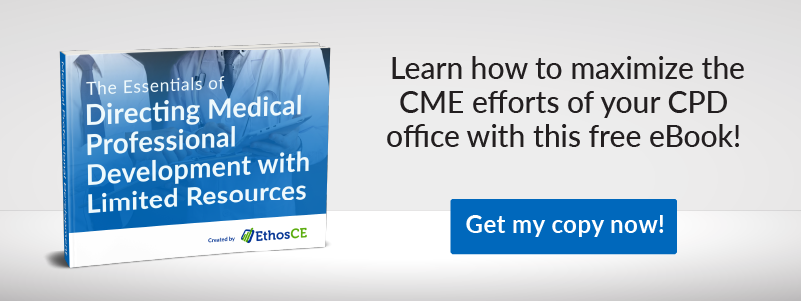4 CPD Best Practices to Improving Continuing Education Programs
Your medical CPD department produces various educational activities to enhance your learners’ medical knowledge and skills, enable them to provide high-quality patient-centered care, work in interprofessional teams, employ evidence-based education, and develop medical, managerial, ethical, social, and personal skills.
As a director, you know everything about CE accreditation and regulatory guidelines and how to implement those standards. However, you may be having issues within your office that can make content creation challenging.
It all has to do with the inner workings of your department.
In this article, we’ll look at best practices for improving your continuing education programs, and we also go over how you can deliver your CE through an outsourcing service.
1. Offer Content That Addresses Diverse Learning Styles
As a CE director, delivering the right content to a wide audience of learners is critical to having them receive deeper learning experiences. Your courses should consider six principles when it comes to adult learning—these help in addressing their diverse learning styles.
- Adult learners are results-oriented and want to know why it’s important to learn something. They want to know what they have to do to learn and what they will be taught.
- They want to exercise control over the techniques and goals in their learning.
- Adults want to connect their life experiences and knowledge with the content learned.
- They are relevancy-oriented. There must be a motive to learn that is linked to the willingness to learn, since their life situations create a particular learning need.
- Adult learners are also generally practical. Their learning is best when it’s presented in a real-life context.
- They show a high motivation to learn when the new information can help them solve significant problems in their lives and/or work.
Your learners will have different learning styles: visual, auditory, kinesthetic (tactile), or reading/writing. To retain learners, your courses should have options for reading text and/or listening to audio and viewing graphics and/or videos.
As you’re developing your continuing education programs, keep these experiences and the other aspects of your learners’ learning styles in mind.
2. Design and Implement Certified CE Activities
You want to offer continuing education programs that improve your learners’ satisfaction rates. Design and implement them with accessibility and learner diversity in mind. By doing so, you not only address disabled learners, but you also increase engagement and satisfaction among the widest range of learners.
What is essential in accessible and universal course design? Consider the following:
- Use simple, consistent navigation that includes a table of contents.
- Control links using keyboard-only navigation.
- Write concise text for every link, with no use of “Click here.”
- Make accommodations for hearing- and visually-impaired learners.
- Provide written descriptions of graphics.
- Use captioned videos and transcribed audio clips.
- Use readable text that matches the content and assessment.
3. Perform Learner Assessments for Your CE Courses
As a CE director, you should assess individual performances and make improvements through relevant learning experiences. Provide online quizzes and surveys to evaluate your learners at any time during your courses, including pre- and post-test activity assessments.
4. Offer CE Courses That Enable Learners to Earn Their Certifications and Licenses
Learners use CE credits to show that they have participated in educational activities and to document having met the requirements of state medical boards, medical specialty societies, hospitals, and other relevant bodies.
The key to your program’s success is to offer accredited, relevant courses that easily allow your learners to gain various board certifications, IPCE, MOC, and AMA PRA Category 1 Credit™ credits. However, it needs your undivided attention, something that may not be there if your CPD office is faced with limited resources.
Look to Expert LMS Administrators for Your CE Tasks
You may find that you’re not providing the very best to your learners, and you must examine the performance of your continuing education programs.
The only problems that can stand in the way are either keeping office staff in place or experiencing budgetary constraints—or both. Content creation becomes more difficult when you always seem to be putting out fires in your department.
After all, the more time that you spend developing and refining your courses—and not on time-consuming administrative tasks—the better experiences your learners will have.
This is where outsourcing your CPD office tasks to a service that can do more than your current staff will be helpful, especially when you are experiencing high employee turnovers. In moving to the outsourcing model, you can concentrate on the best practices that let you continue to improve your continuing education programs.
Deliver Your CE Effectively with EthosCE’s Concierge Service
Your CPD office is a busy one and may have issues surrounding limited resources. But you need to get your continuing education content online as quickly as possible. When you can’t, that means less time spent on innovation.
EthosCE offers an LMS concierge service that helps you resolve staff turnover problems, allowing you to increase the number of activities and continuing education programs that your office can provide.
This external professional service performs tasks more cheaply, quickly, and efficiently and with greater quality than students or temps. It can also be done remotely or on a retainer basis and costs less than a full-time employee.
This service provides you with access to expert LMS technical resources. It also enables you to offload your admin tasks, and you can use it in any number of ways:
- Setting up courses
- Creating and sending reports
- Pulling data
- Creating, reviewing, and updating forms
- Emailing learners
- Providing end-user support
- Performing data entry
- Recording documentation
- Doing supplemental training
EthosCE also provides experienced project managers and dedicated data-entry staff to make sure your course production stays on track.
This service enables you to:
- Earn more from your existing course content.
- Spend more time on innovation.
- Take advantage of best practices in course delivery so your learners receive the best value from your courses.
- Save money from flat-fee course pricing.
Accomplish Your CE Goals without the Problems of Limited Resources
When it comes to creating your CE courses, you need ways to accomplish your goals. EthosCE’s concierge service frees you from daily office tasks. You can then deliver innovative courses so your learners can have the best possible experience.
Put your best practices into motion and improve how you deliver your CCMEE. Contact us for a free 1-on-1 demo with one of our specialists today.
 We're now part of the Cadmium product suite! Learn more
We're now part of the Cadmium product suite! Learn more 


